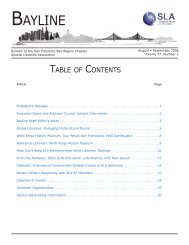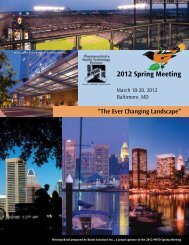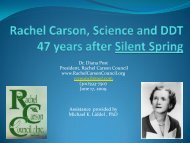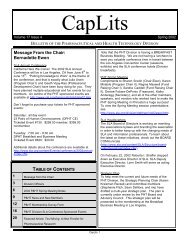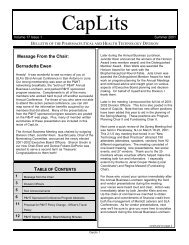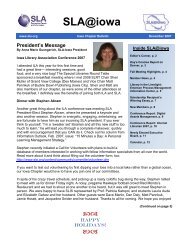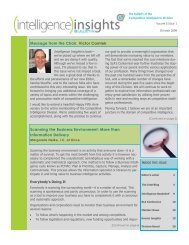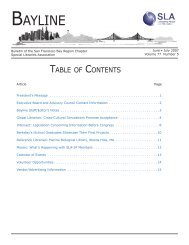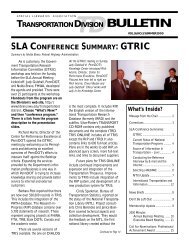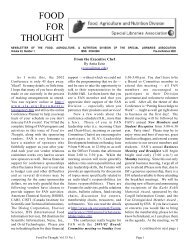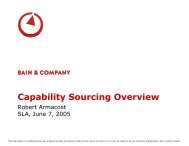Education Libraries - Special Libraries Association
Education Libraries - Special Libraries Association
Education Libraries - Special Libraries Association
You also want an ePaper? Increase the reach of your titles
YUMPU automatically turns print PDFs into web optimized ePapers that Google loves.
These statements address areas of growth and<br />
change critical to developing a curriculum center<br />
for the twenty-first century. The Curriculum<br />
Center had a traditional, print-based collection<br />
built primarily with donated materials and<br />
organized using multiple classification systems<br />
(some of which were developed in-house). The<br />
challenge was to implement the vision promoting<br />
a dynamic, evolving center accessible to a diverse<br />
community of users.<br />
Articulating a clear, concise, and memorable<br />
statement of purpose is more difficult than it<br />
sounds. Using <strong>Libraries</strong>, Mission & Marketing:<br />
Writing Mission Statements That Work as a guide<br />
(Wallace, 2004), Meyer and Miller worked on<br />
several versions of a mission statement for the<br />
Curriculum Center. Early drafts of the statement<br />
reflect the recurring questions or themes in<br />
redefining the Curriculum Center: the primary<br />
stakeholders, the scope of its collections and<br />
services, the need to be dynamic and proactive,<br />
and an emphasis on high quality resources. After<br />
several drafts, Miller and Meyer arrived at this<br />
statement:<br />
The Curriculum Center promotes excellence in<br />
teaching through the use of quality resources.<br />
The final mission statement is broad, in that it<br />
does not specify stakeholders or scope of<br />
collections and services, as some of the earlier<br />
drafts do, but it meets the criteria of being clear,<br />
concise, and memorable. (See Appendix B for a<br />
discussion of the<br />
process of refining the<br />
mission statement.)<br />
A breakthrough in the<br />
visioning process was<br />
the articulation of<br />
guiding<br />
principles. The<br />
guiding principles<br />
articulate the library’s<br />
fundamental<br />
assumptions about a<br />
curriculum center for<br />
the twenty-first<br />
century. These<br />
principles evolved through discussions with<br />
stakeholders and then were refined in the context<br />
of the vision, values, and mission statements. In<br />
January, 2007, Meyer and Miller presented the<br />
Curriculum Center’s foundational document<br />
(including vision, values, and mission statements<br />
and guiding principles) to the EWU <strong>Libraries</strong>’<br />
Dean’s Council for approval, where it was<br />
adopted. (See Appendix A for the full text of the<br />
document.) This foundation document has guided<br />
the decisions that have followed in transforming<br />
the Curriculum Center.<br />
Existence of Essential Structures<br />
The third condition for transformation of EWU<br />
<strong>Libraries</strong>’ Curriculum Center has been the<br />
existence of “good bones,” those essential<br />
structures upon which to build. The center’s<br />
physical facility is one essential structure. When<br />
the JFK Library was remodeled in 1998, the<br />
renovation provided an attractive and adequate<br />
space for the Curriculum Center (4344 square feet<br />
on the ground floor of the library). The center<br />
included two study rooms separated by an<br />
accordion-like room divider that could be pushed<br />
back to make a larger room. An open area with<br />
study tables was located next to large, north-facing<br />
windows; fabric-covered bulletin boards along one<br />
wall were designed for displays. Many of these<br />
features, however, were hidden behind tall<br />
shelving. The center lacked technology; wireless<br />
connections were accessible, but electrical outlets<br />
and network ports were limited to two areas.<br />
Blank walls, empty shelves, and old materials<br />
contributed to a<br />
feeling of neglect.<br />
The library has made<br />
several improvements<br />
to make the<br />
Curriculum Center<br />
more inviting. A new<br />
display area lines the<br />
path from the Lower<br />
Level Service Desk to<br />
the entrance of the<br />
Curriculum<br />
Center. Staff removed<br />
four sections of empty<br />
shelving, creating an<br />
<strong>Education</strong> <strong>Libraries</strong>, Volume 31, No. 2, Winter 2008 22



